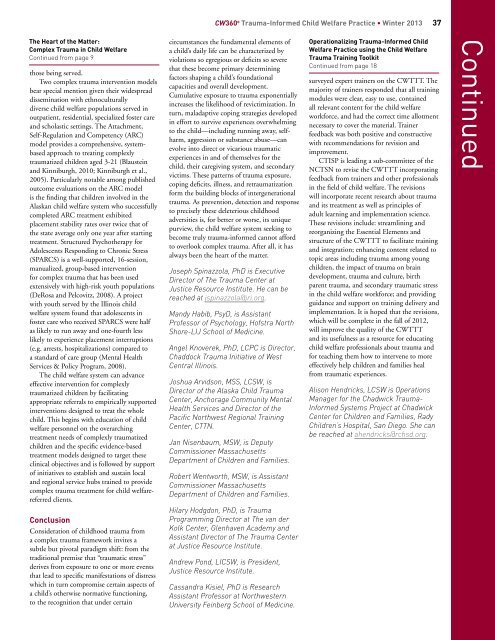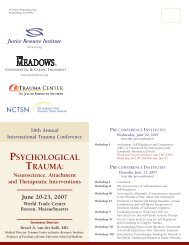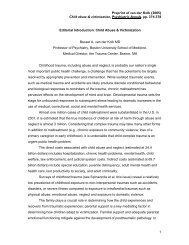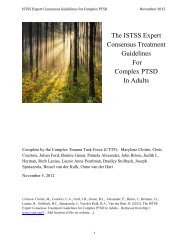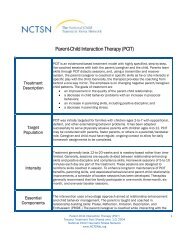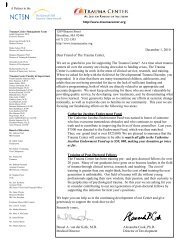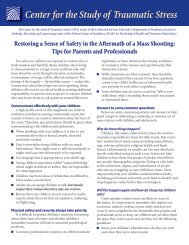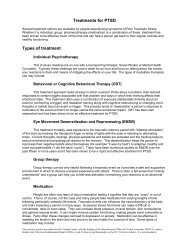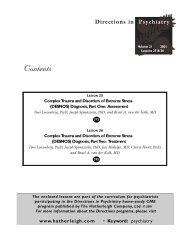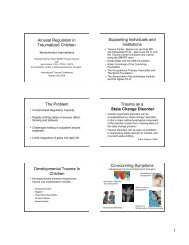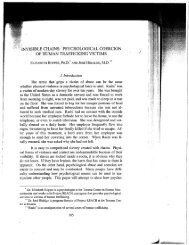in Child Welfare - The Trauma Center
in Child Welfare - The Trauma Center
in Child Welfare - The Trauma Center
You also want an ePaper? Increase the reach of your titles
YUMPU automatically turns print PDFs into web optimized ePapers that Google loves.
CW360 o <strong>Trauma</strong>-Informed <strong>Child</strong> <strong>Welfare</strong> Practice • W<strong>in</strong>ter 2013 37<strong>The</strong> Heart of the Matter:Complex <strong>Trauma</strong> <strong>in</strong> <strong>Child</strong> <strong>Welfare</strong>Cont<strong>in</strong>ued from page 9those be<strong>in</strong>g served.Two complex trauma <strong>in</strong>tervention modelsbear special mention given their widespreaddissem<strong>in</strong>ation with ethnoculturallydiverse child welfare populations served <strong>in</strong>outpatient, residential, specialized foster careand scholastic sett<strong>in</strong>gs. <strong>The</strong> Attachment,Self-Regulation and Competency (ARC)model provides a comprehensive, systembasedapproach to treat<strong>in</strong>g complexlytraumatized children aged 3-21 (Blauste<strong>in</strong>and K<strong>in</strong>niburgh, 2010; K<strong>in</strong>niburgh et al.,2005). Particularly notable among publishedoutcome evaluations on the ARC modelis the f<strong>in</strong>d<strong>in</strong>g that children <strong>in</strong>volved <strong>in</strong> theAlaskan child welfare system who successfullycompleted ARC treatment exhibitedplacement stability rates over twice that ofthe state average only one year after start<strong>in</strong>gtreatment. Structured Psychotherapy forAdolescents Respond<strong>in</strong>g to Chronic Stress(SPARCS) is a well-supported, 16-session,manualized, group-based <strong>in</strong>terventionfor complex trauma that has been usedextensively with high-risk youth populations(DeRosa and Pelcovitz, 2008). A projectwith youth served by the Ill<strong>in</strong>ois childwelfare system found that adolescents <strong>in</strong>foster care who received SPARCS were halfas likely to run away and one-fourth lesslikely to experience placement <strong>in</strong>terruptions(e.g. arrests, hospitalizations) compared toa standard of care group (Mental HealthServices & Policy Program, 2008).<strong>The</strong> child welfare system can advanceeffective <strong>in</strong>tervention for complexlytraumatized children by facilitat<strong>in</strong>gappropriate referrals to empirically supported<strong>in</strong>terventions designed to treat the wholechild. This beg<strong>in</strong>s with education of childwelfare personnel on the overarch<strong>in</strong>gtreatment needs of complexly traumatizedchildren and the specific evidence-basedtreatment models designed to target thesecl<strong>in</strong>ical objectives and is followed by supportof <strong>in</strong>itiatives to establish and susta<strong>in</strong> localand regional service hubs tra<strong>in</strong>ed to providecomplex trauma treatment for child welfarereferredclients.ConclusionConsideration of childhood trauma froma complex trauma framework <strong>in</strong>vites asubtle but pivotal paradigm shift: from thetraditional premise that “traumatic stress”derives from exposure to one or more eventsthat lead to specific manifestations of distresswhich <strong>in</strong> turn compromise certa<strong>in</strong> aspects ofa child’s otherwise normative function<strong>in</strong>g,to the recognition that under certa<strong>in</strong>circumstances the fundamental elements ofa child’s daily life can be characterized byviolations so egregious or deficits so severethat these become primary determ<strong>in</strong><strong>in</strong>gfactors shap<strong>in</strong>g a child’s foundationalcapacities and overall development.Cumulative exposure to trauma exponentially<strong>in</strong>creases the likelihood of revictimization. Inturn, maladaptive cop<strong>in</strong>g strategies developed<strong>in</strong> effort to survive experiences overwhelm<strong>in</strong>gto the child—<strong>in</strong>clud<strong>in</strong>g runn<strong>in</strong>g away, selfharm,aggression or substance abuse—canevolve <strong>in</strong>to direct or vicarious traumaticexperiences <strong>in</strong> and of themselves for thechild, their caregiv<strong>in</strong>g system, and secondaryvictims. <strong>The</strong>se patterns of trauma exposure,cop<strong>in</strong>g deficits, illness, and retraumatizationform the build<strong>in</strong>g blocks of <strong>in</strong>tergenerationaltrauma. As prevention, detection and responseto precisely these deleterious childhoodadversities is, for better or worse, its uniquepurview, the child welfare system seek<strong>in</strong>g tobecome truly trauma-<strong>in</strong>formed cannot affordto overlook complex trauma. After all, it hasalways been the heart of the matter.Joseph Sp<strong>in</strong>azzola, PhD is ExecutiveDirector of <strong>The</strong> <strong>Trauma</strong> <strong>Center</strong> atJustice Resource Institute. He can bereached at jsp<strong>in</strong>azzola@jri.org.Mandy Habib, PsyD, is AssistantProfessor of Psychology, Hofstra NorthShore-LIJ School of Medic<strong>in</strong>e.Angel Knoverek, PhD, LCPC is Director,Chaddock <strong>Trauma</strong> Initiative of WestCentral Ill<strong>in</strong>ois.Joshua Arvidson, MSS, LCSW, isDirector of the Alaska <strong>Child</strong> <strong>Trauma</strong><strong>Center</strong>, Anchorage Community MentalHealth Services and Director of thePacific Northwest Regional Tra<strong>in</strong><strong>in</strong>g<strong>Center</strong>, CTTN.Jan Nisenbaum, MSW, is DeputyCommissioner MassachusettsDepartment of <strong>Child</strong>ren and Families.Robert Wentworth, MSW, is AssistantCommissioner MassachusettsDepartment of <strong>Child</strong>ren and Families.Hilary Hodgdon, PhD, is <strong>Trauma</strong>Programm<strong>in</strong>g Director at <strong>The</strong> van derKolk <strong>Center</strong>, Glenhaven Academy andAssistant Director of <strong>The</strong> <strong>Trauma</strong> <strong>Center</strong>at Justice Resource Institute.Andrew Pond, LICSW, is President,Justice Resource Institute.Cassandra Kisiel, PhD is ResearchAssistant Professor at NorthwesternUniversity Fe<strong>in</strong>berg School of Medic<strong>in</strong>e.Operationaliz<strong>in</strong>g <strong>Trauma</strong>-Informed <strong>Child</strong><strong>Welfare</strong> Practice us<strong>in</strong>g the <strong>Child</strong> <strong>Welfare</strong><strong>Trauma</strong> Tra<strong>in</strong><strong>in</strong>g ToolkitCont<strong>in</strong>ued from page 18surveyed expert tra<strong>in</strong>ers on the CWTTT. <strong>The</strong>majority of tra<strong>in</strong>ers responded that all tra<strong>in</strong><strong>in</strong>gmodules were clear, easy to use, conta<strong>in</strong>edall relevant content for the child welfareworkforce, and had the correct time allotmentnecessary to cover the material. Tra<strong>in</strong>erfeedback was both positive and constructivewith recommendations for revision andimprovement.CTISP is lead<strong>in</strong>g a sub-committee of theNCTSN to revise the CWTTT <strong>in</strong>corporat<strong>in</strong>gfeedback from tra<strong>in</strong>ers and other professionals<strong>in</strong> the field of child welfare. <strong>The</strong> revisionswill <strong>in</strong>corporate recent research about traumaand its treatment as well as pr<strong>in</strong>ciples ofadult learn<strong>in</strong>g and implementation science.<strong>The</strong>se revisions <strong>in</strong>clude: streaml<strong>in</strong><strong>in</strong>g andreorganiz<strong>in</strong>g the Essential Elements andstructure of the CWTTT to facilitate tra<strong>in</strong><strong>in</strong>gand <strong>in</strong>tegration; enhanc<strong>in</strong>g content related totopic areas <strong>in</strong>clud<strong>in</strong>g trauma among youngchildren, the impact of trauma on bra<strong>in</strong>development, trauma and culture, birthparent trauma, and secondary traumatic stress<strong>in</strong> the child welfare workforce; and provid<strong>in</strong>gguidance and support on tra<strong>in</strong><strong>in</strong>g delivery andimplementation. It is hoped that the revisions,which will be complete <strong>in</strong> the fall of 2012,will improve the quality of the CWTTTand its usefulness as a resource for educat<strong>in</strong>gchild welfare professionals about trauma andfor teach<strong>in</strong>g them how to <strong>in</strong>tervene to moreeffectively help children and families healfrom traumatic experiences.Alison Hendricks, LCSW is OperationsManager for the Chadwick <strong>Trauma</strong>-Informed Systems Project at Chadwick<strong>Center</strong> for <strong>Child</strong>ren and Families, Rady<strong>Child</strong>ren’s Hospital, San Diego. She canbe reached at ahendricks@rchsd.org.Cont<strong>in</strong>ued


